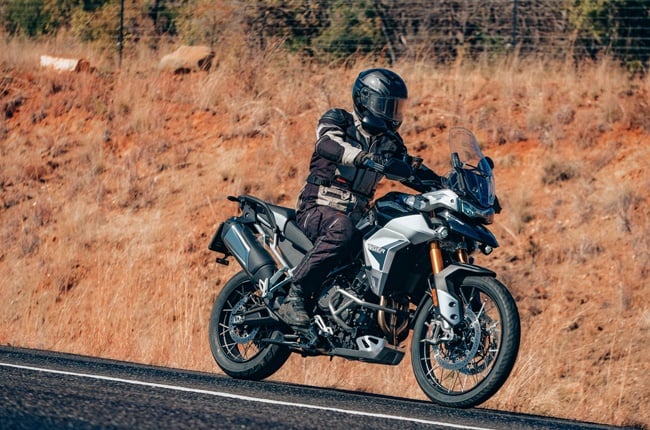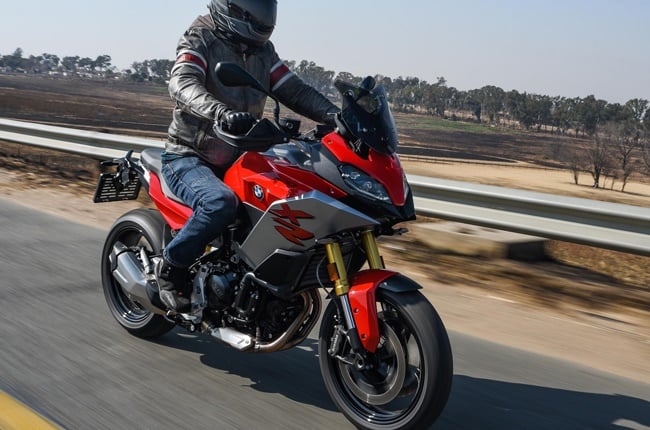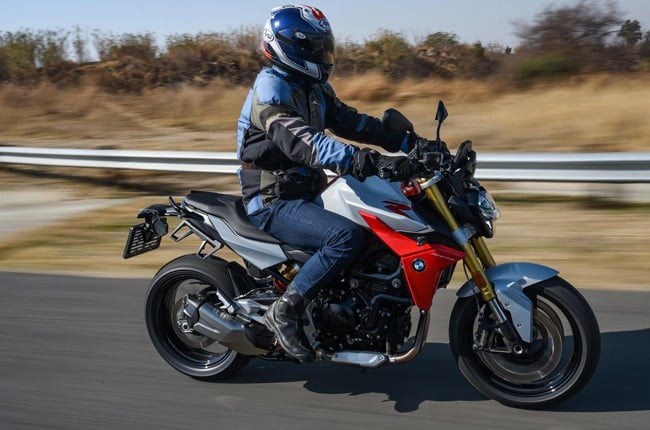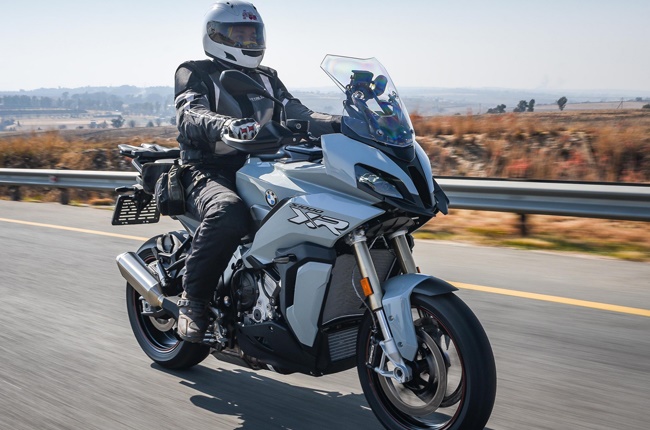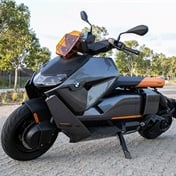• BMW and Triumph launched new bikes in South Africa.
• The bikes each cater to a different need, ranging from on-road to off-road.
• The launch route covered lots of gravel.
• For more motoring stories, go to www.Wheels24.co.za
Two bike manufacturers recently allowed the media to ride new additions to the local market - a total of five different bikes, all of which, bar one, fall into the midrange category.
While four of the five bikes - two from BMW and two from Triumph - have 900cm³ engines, there are significant differences in both target market and mechanical configuration.
Triumph's two entries - the off-road-oriented Tiger 900 Rally Pro and the more road-focussed GT Pro - sport the British brand's familiar three-cylinder DOHC engine with a capacity of 888cm³. Maximum power output is 70kW @ 8750rpm, and maximum torque is 87Nm @ 7250rpm.
These bikes, while evolved from the Tiger 800 that was introduced in 2010, trace their lineage much further back. Triumph introduced the first competition bikes under the Tiger moniker in 250cm³, 350cm³ and 500cm³ capacities in 1937.
Triumph Tiger 900 Rally Pro (Joe Fleming)
Pleasure to ride
Depending on the model, Triumph has shaved up to 5kg weight off the 900s, and gave the bikes a new modular steel trellis frame with bolt-on aluminium rear sub-frame and pillion hangers. The bikes also sport Marzocchi (on the GT Pro) and Showa (on the Rally Pro) suspension components, which in combination with the more accessible torque, make them an absolute pleasure to ride both on and off the road.
I had the opportunity to ride the Tiger 900s and the outgoing 800 on the same day, allowing me to compare the 900s to their predecessor directly. The increased responsiveness of the new bikes was immediately evident, both in traffic and on the two stretches of dirt road included in our route.
The new bikes also feel decidedly more sporty, out-accelerating their predecessor with ease, a boon for potential customers who would like a little added oomph in Triumph's well-respected mid-size adventurers.
Triumph Tiger 900 GT (Joe Fleming)
Twins to the battle
BMW brought twins to the battle, in the form of the naked F 900 R and the F 900 XR; the smaller sibling of the S 1000 XR (the latest version of which was the fifth bike I alluded to earlier). Adding the big XR to the mix was an interesting choice by Motorrad South Africa, because while its S 1000 RR-derived four-cylinder engine meant that it handsomely outperformed the two Bavarian 900s, it also placed the F 900 XR particularly into perspective.
BMW Motorrad says that the F 900 R and XR currently set the technological benchmark in the mid-range segment. They sport both high-quality standard equipment such as connectivity features, all-round LED lighting, and a wide range of optional extras such as an Adaptive Cornering Light, Keyless Ride, Dynamic ESA, Riding Modes Pro, Shift Assistant Pro, ABS Pro and more.
The 895cm³ inline twin motor which does duty in both models is a further development of the 853cm³ mill of the F 850 GS, now boasting 77kW and an even fuller torque curve. Besides increasing the capacity, the white coats from Bavaria have also modified the ignition distance to 270/450 degrees and fitted a new underfloor silencer system to improve the perceived sound the engine emits.
BMW F 900 XR (Rob Till)
Shorter, slimmer rear
Like the F-series, GS models the 900 R and XR sport a steel bridge frame that integrates the engine as a load-bearing element, and a fuel tank which has been returned to the more traditional position in front of the rider. Motorrad says that the light, plastic-welded fuel tanks (15.5 litres on the XR and 13 litres on the R) are a world-first in motorcycle construction.
The bolt-on steel rear frame has also been newly developed for the F 900 R and F 900 XR to create a visually shorter and slimmer rear.
The increased performance is noticeable on the road, with both the bikes feeling agile and lively. Both bikes inspire confidence in the handling department. While one might expect the XR's longer suspension travel to cause it to suffer in comparison with its sibling, during normal road use (which the ride-out mostly consisted of), even riding the two back-to-back, this doesn't seem to be the case. Both these bikes promise to be excellent all-purpose mounts.
While I enjoyed the sportier nature of the R, I would personally prefer the XR for its more relaxed riding position and better protection against the elements.
BMW F 900 R (Rob Till)
Hefty power
The fifth bike I rode was the always impressive S 1000 XR, which after its current makeover, is now even more so. With its S 1000 RR-derived inline-four motor, the big XR was the odd one out among the mid-rangers – understandably so, since it kicks out a hefty 121kW of power and 114Nm of torque. Here's where its sportbike heritage shows because both peaks occur at quite high in the rev range: 9 250rpm for the torque and 11 000rpm for the power.
It is noticeably lighter and more agile than its predecessor, the newly-developed engine and suspension helped to reduce its dry weight of 226kg - 10 kg less than the previous version when adjusted for equipment. But the XR is more than just a fast bike; it is a pukka adventure sportbike coming with a host of standard features, such as Dynamic ESA, riding modes Pro, ABS Pro and Dynamic Traction Control (DTC), Hill Start Control Pro, a 6.5-inch TFT screen complete with connectivity and full LED lighting.
On the road, the contrast between the 1000 XR and 900 XR is stark, with the performance of the former putting it in a whole different ballpark, despite only 100 cm³ (give or take) difference in capacity. The performance gap between the two is huge, but so is the price difference. With this in mind, I evaluated the 900 XR critically to answer my own question: is there a place for the 900? The answer is that, unless you need (or want) superbike performance, or want to do regular two-up touring, the smaller XR is definitely a viable option. It is light and nimble, as comfortable as its bigger sibling, and in the vicinity of R100 000 easier on your wallet.
These five bikes are more than welcome additions to the current marketplace. From the sports roadster BMW F 900 R to the adventure-focussed Triumph Tiger 900 Rally Pro, to the middle ground of adventure touring as represented by the Tiger 900 GT Pro and the two BMW XRs, between them the five new bikes cover quite a portion of the market.
Just don't ask me to pick a favourite - that would be as unfair, and as impossible, as being asked to name your favourite child.
BMW S 1000 XR (Rob Till)




 Publications
Publications
 Partners
Partners




